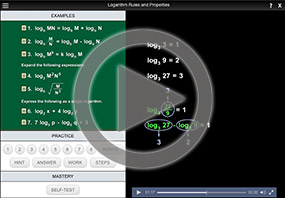Condensing Log Expressions
Purplemath
How do you condense logarithms?
To condense logarithms, we use log rules to combine separate logarithmic terms. For instance, the expression log7(3) + log7(x) can be combined by using the Product Rule to get log7(3×x) = log7(3x).
Content Continues Below
Why do we condense logs?
We oftentimes condense logs in order to create one term that we can evaluate all at once, rather than having to evaluate multiple terms separately. This can be helpful, say, when you're graphing; instead of evaluating six terms and combining their results for each and every graphing point, we can instead evaluate one (perhaps big and lumpy) log term.
When they tell you to "simplify" a log expression, this usually means they will have given you lots of log terms, each containing a simple argument, and they want you to combine everything into one log with a complicated argument. "Simplifying" in this context usually means the opposite of "expanding".
There is no standard definition, in this context, for "simplifying". You have to use your own good sense. If they give you a big complicated thing and ask you to "simplify", then they almost certainly mean "expand". If they give you a string of log terms and ask you to "simplify", then they almost certainly mean "condense".
Let's see how condensing log expressions works in action.
- Simplify log2(x) + log2(y)
Since these logs have the same base, the Product Rule says that the addition outside the two logs can be turned into multiplication inside one log:
log2(x) + log2(y) = log2(xy)
Then the answer is:
log2(xy)
- Simplify log3(4) − log3(5)
Since these logs have the same base, the Quotient Rule says that the subtraction outside the two logs can be turned into division inside one log:
Then my answer is:
Content Continues Below
- Simplify 2log3(x)
The Power Rule says that the multiplier out in front of the log can be turned into an exponent on the insides of the log:
2 · log3(x) = log3(x2)
Then my final answer is:
log3(x2)
- Simplify 3log2(x) − 4log2(x + 3) + log2(y)
Using the Power Rule, I will get rid of the multipliers outside the logs by moving them inside the logs as powers:
3log2(x) − 4log2(x + 3) + log2(y)
= log2(x3) − log2((x + 3)4) + log2(y)
Then I'll move the terms in order to put the added terms together, leaving the one "minus" term to the end of the string:
log2(x3) − log2((x + 3)4) + log2(y)
= log2(x3) + log2(y) − log2((x + 3)4)
I'll apply the Product Rule to convert the addition between the first two log terms into multiplication inside one combined log term:
log2(x3) + log2(y) − log2((x + 3)4)
= log2(x3y) − log2((x + 3)4)
Then I'll account for the subtracted term by applying the Quotient Rule to move it inside, dividing the insides of the other term:
Then my final answer is:
Affiliate
Pay particular attention to how I grouped the log terms according to sign. This can be very important, and is where many students get lost and then lose points. Don't try to convert addition outside to multiplication inside, or subtraction outside to division inside, until you've made sure that all the "plus" terms are together up front, followed by all the "minus" terms. Then you can combine by multiplication within each set, and then finish by converting the big "minus" that's subtracted from the big "plus" into one big division inside one log.
- Condense all terms into one logarithm: 5 + log7(x)
How the heck am I supposed to combine the 5 with the log?
While the Log-Cancelling Rule is usually applied to simplify away from logs, I can use it to go the other way; in other words, I can apply the Log-Cancelling Rule to go backwards from the number to a log expression. This Rule gives me:
5 = log7(75)
This Rule is almost never used this way, but it does what they want of me; namely, it converts a plain number into a log expression, which I can then combine (via the Product Rule) into one log. Just in case they want the numeric part evaluated, I'll turn the 75 into 16807:
log7(75) + log7(x) = log7(16807x)
I don't know if they want the 75 to be multiplied out, so I'l include both forms in the answer, just to be safe:
log7(75x) = log7(16807x)
How do you condense logs with fractions in front?
To condense a logarithm that is multiplied by a fraction, we can use the fact that fractional powers can be turned into radicals. For instance, the one-third power is the cube root.
- Condense into one logarithm:
The one-half that is multiplied onto the first log can be taken inside (by the Power Rule) as an exponent:
The one-half power means the same thing as a square root, so I get:
Now I can combine the two logs by using the Quotient Rule:
I don't see anything more I can do with this, so my hand-in answer is:
You can use the Mathway widget below to practice simplifying a logarithmic expression. Try the entered exercise, or type in your own exercise. Then click the button to compare your answer to Mathway's. (Or skip the widget and continue with the lesson.)
Please accept "preferences" cookies in order to enable this widget.
(Clicking on "Tap to view steps" on the widget's answer screen will take you to the Mathway site for a paid upgrade.)
URL: https://www.purplemath.com/modules/logrules3.htm
Select a Course Below
Standardized Test Prep
Homeschool Math
© 2024 Purplemath, Inc. All right reserved. Web Design by ![]()



